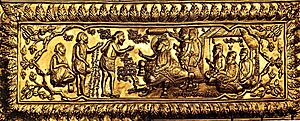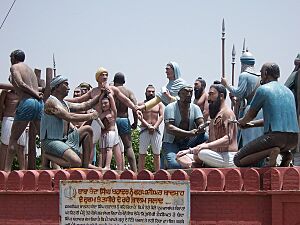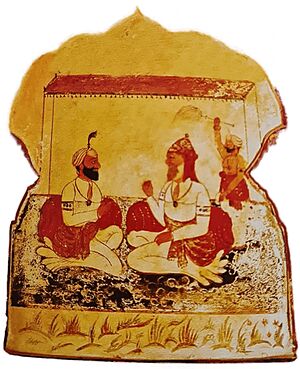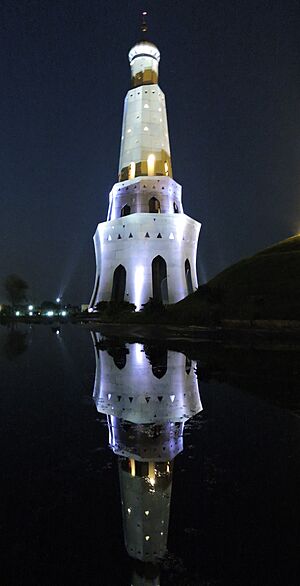Banda Singh Bahadur facts for kids
Quick facts for kids
Banda Singh Bahadur
|
|
|---|---|
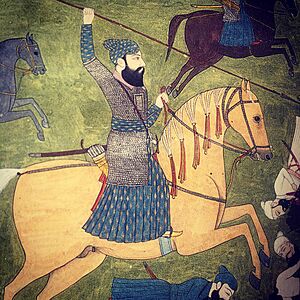
Depiction of Banda Singh Bahadur, during the Battle of Sirhind (1710), from an illustrated folio of ‘Tawarikh-i Jahandar Shah’, Awadh or Lucknow, ca.1770
|
|
| Birth name | Lachman Dev |
| Other name(s) | Madho Das Bairagi, Banda Bairagi |
| Born | 27 October 1670 Rajauri, Poonch, Mughal Empire (present-day Jammu and Kashmir, India) |
| Died | 9 June 1716 (aged 45) Delhi, Mughal Empire (present-day India) |
| Allegiance |
|
| Years of service | 1708–1716 |
| Rank | Jathedar |
| Spouse(s) | Susheel Kaur Sahib Kaur |
| Children | Ajay Singh Ranjit Singh |
| Signature | 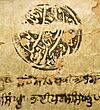 |
| Religion | Sikhism |
| Teacher | Guru Gobind Singh |
|
Banda Singh Bahadur
|
|
|---|---|
| Battles/wars |
|
Banda Singh Bahadur (born Lachman Dev) was a brave Sikh warrior and a general of the Khalsa Army. He was born on October 27, 1670, and passed away on June 9, 1716. When he was 15, he decided to leave his home and become an ascetic, a person who lives a simple life away from worldly things. He was then known as Madho Das Bairagi. He set up a monastery in Nānded.
In 1708, Guru Gobind Singh, the tenth Sikh Guru, met Banda Singh Bahadur. Banda was deeply inspired and became a follower of Guru Gobind Singh. He was given a new name, Gurbaksh Singh, after a special ceremony. However, he is most famously known as Banda Singh Bahadur. The Guru gave him five special arrows as a blessing for the battles he would fight. Banda Singh Bahadur then went to Khanda, Sonipat and gathered a strong fighting force. He led the fight against the Mughal Empire, which was a powerful empire at that time.
One of his first big victories was taking over Samana in November 1709. After gaining control in Punjab, Banda Singh Bahadur made important changes. He ended the zamindari system, which was a feudal system where landlords owned all the land. Instead, he gave land rights directly to the farmers who worked the land. Banda Singh Bahadur was later captured by the Mughals and died in 1716.
Contents
Early Life and Becoming an Ascetic
Banda Singh Bahadur was born as Lachman Dev on October 27, 1670. His family was Hindu and his father, Ram Dev, was a farmer in Rajouri, which is now in Jammu and Kashmir. His family was not wealthy.
Not much is known about his early childhood. However, Banda Singh loved hunting and shooting. He quickly learned skills like horseriding, wrestling, archery, and swordsmanship. A story from his youth tells how, at age 15, he was hunting a doe. He was deeply saddened when he saw the doe dying. He was even more upset when he found two unborn fawns also dying inside the doe. This event had a strong impact on him. It made Banda Singh leave his worldly life and become an ascetic. He met another ascetic named Janaki Prasad, who changed Lachman Dev's name to Madho Das. Banda Singh then started his own monastery, called a Dera, and gained some followers.
Meeting Guru Gobind Singh
In 1708, Guru Gobind Singh visited Madho Das's monastery. The Guru sat on Madho Das's special seat, where Madho Das usually sat as a saint. Some stories say Guru Gobind Singh also killed some goats there. Madho Das was very angry when he heard this. He tried to use his "magic" to flip the Guru's chair, but nothing happened.
Madho Das then went to confront the Guru. But when he saw the Guru, his anger disappeared. After talking with the Guru, Madho Das decided to convert to Sikhism. He took Amrit, a special Sikh baptism ceremony, and became a Khalsa. Guru Gobind Singh named him Banda Singh. Banda Singh learned about Gurbani (Sikh scriptures) and Sikh history. He was very sad when he heard about the cruel killing of Guru Gobind Singh's two younger sons, Zorawar Singh and Fateh Singh. Guru Gobind Singh told Banda Singh that when people are treated unfairly, it is the duty of brave individuals to fight against it, even if it means risking their lives. Banda Singh wanted to do just that. He wished to fulfill Guru Gobind Singh’s goal of punishing those who were cruel and protecting ordinary people.
Military Campaigns
Beginning His Mission
Soon after, Guru Gobind Singh was attacked and later passed away. This made Banda Singh very angry. He asked the Guru to send him to Punjab to get justice for the Sikhs and punish the cruel rulers. In September 1708, Guru Gobind Singh gave Banda Singh the title of "Bahadur" (meaning brave). He also gave Banda Singh full power to lead the Sikh fight. Banda Singh was tasked with punishing those who had done wrong and getting revenge for the killing of the Guru's sons.
He was given a Nagara (war drum), a Nishan Sahib (Sikh flag), and 5 arrows from Guru Gobind Singh. Five trusted Sikhs, known as Panj Pyare (Ram Singh, Binod Singh, Kahan Singh, Baj Singh, and Daya Singh), were sent to help him. Banda Singh was also joined by 20 other Sikhs. The Guru told him to always be honest and pure-hearted, to respect women, and to see himself as a servant of the Khalsa and the Guru. He was told to always pray before acting and to seek advice from the Panj Pyare. He was also warned not to call himself a Guru or start his own groups, and not to let victories make him proud or losses make him sad.
Banda Singh also received special letters, called Hukamnamas, from Guru Gobind Singh. These letters told all Sikhs to join him in his war against the Mughal Empire. He was made the Jathedar (leader) of the Khalsa. Banda Singh then set off for Punjab with about 300 cavalry (horse soldiers) following him.
Guru Gobind Singh passed away on October 7, 1708, during Banda Singh's journey. Banda Singh traveled in disguise for most of the trip. He followed the same path Guru Gobind Singh had taken through Maharashtra and Rajputana. He traveled about 16 kilometers (10 miles) each day. It took him a year to reach Punjab.
Early Victories
Banda Singh soon arrived in what is now Haryana. He quickly gained the support of the local people. He moved towards the region of Bagar and successfully stopped local bandits and robbers. He shared what he took from the thieves with the poor. This made Banda Singh famous. People honored him publicly. He gained the support of villagers and encouraged many to join the Khalsa. Banda Singh then went to the villages of Sehri and Khanda. From these villages, he sent letters to Sikh communities in the Majha, Doaba, and Malwa regions of Punjab. He asked them to join his fight against the Mughal rulers. In these letters, Banda Singh reminded the Sikhs of the cruel deaths of Guru Gobind Singh's two younger sons, who were killed on the orders of Wazir Khan, the Governor of Sirhind. Because of these letters, Banda Singh started getting a lot of support from Sikh communities in Punjab. He was joined by brave warriors like Fateh Singh, Karam Singh, and Dharm Singh. Tilok Singh and Ram Singh Phulkian gave soldiers and money. Even Ali Singh and Mali Singh, who used to work for Wazir Khan, joined Banda Singh.
Taking Over Sonipat and Kaithal
Banda Singh, with 500 soldiers, attacked Sonipat, which was close to the Mughal capital, Delhi. The Mughal commander of Sonipat was defeated, and the Sikhs took over the city. Banda Singh took money from the royal treasury and the rich, sharing it among his men. This attack so close to Delhi was a clear challenge to the Mughals.
Next, Banda Singh aimed for Samana. On the way, he attacked a Mughal group near Kaithal that was carrying royal treasure to Delhi. Banda Singh successfully took the treasure. The Governor of Kaithal was furious and attacked the Sikhs. Banda Singh and his Sikhs fought hard. Since most of the Sikhs were foot soldiers against Mughal cavalry, they faced difficulties. Banda Singh came up with a plan: the Sikhs ran into a thorny forest, forcing the Mughal cavalry to leave their horses. The Sikhs then came out and took the horses. Many Mughals were killed, and some surrendered. The Governor was captured but released after agreeing to let the Sikhs keep the horses. The captured wealth was shared among Banda Singh’s followers.
Campaign in Haryana and East
Banda Singh decided to go east towards Kiratpur. His goal was to free Sikhs from Majha and Doaba who were held in places like Malerkotla and Ropar. Along the way, Banda Singh conquered Ghurman and Thaska. Ghurman put up a small fight, but Thaska surrendered easily.
Banda Singh then attacked Kunjpura, which was Wazir Khan's home village. Wazir Khan's troops and cannons were there, but the Sikhs defeated them. Banda Singh next attacked Shahabad, a Muslim town. Banda Singh and the Sikh forces destroyed it. He also attacked Damala, the home of the Pathans who had abandoned Guru Gobind Singh in the Battle of Bhangani. Banda Singh then marched on Mustafabad. The commander of Mustafabad sent 2,000 imperial troops with 2 cannons to stop Banda Singh. Banda Singh and the Sikhs defeated the Mughals, who left their cannons behind as they ran away. The town was looted, and the commander was punished for his cruelty.
Battle of Kapuri
Banda Singh heard about Qadam-ud-din, the landlord of Kapuri. He was known for his bad behavior and for hurting Hindus and Sikhs. He would interfere with Hindu weddings and kidnap young brides. Banda Singh immediately attacked Kapuri, killed Qadam-ud-din, and captured his fort. This victory also brought a lot of valuable goods and war supplies.
Battle of Sadhaura
Banda Singh’s next target was Sadhaura. It was ruled by Osman Khan, who had killed a Muslim saint, Syed Pir Budhu Shah, for helping Guru Gobind Singh. Osman Khan also treated Hindus cruelly. He would slaughter cows in front of their homes and stopped Hindus and Sikhs from performing their religious ceremonies, like cremating their dead. All these actions made Sadhaura a target for Banda Singh.
As Banda Singh moved towards Sadhaura, local people and farmers joined his revolt. The angry crowd became unstoppable and destroyed everything. The Sayyids and Shaikhs were killed. Osman Khan was hanged, and Sadhaura was captured.
Ropar
Wazir Khan found out that Sikhs from Majha had gathered at Kiratpur Sahib to join Banda Singh. When the Sikhs reached Ropar, Sher Mohammad Khan, along with other Mughal leaders, was there to block them and fight. The Mughals had better weapons and more cavalry (horse soldiers), while the Sikhs had a smaller army with fewer weapons. Both sides fought a bloody battle. A strong dust storm forced both armies to stop for the night. The next day, more Sikhs arrived to help their comrades. A bullet hit Khizar Khan in the head, causing confusion among the Mughals. Nashtar and Wali Mohammad Khan tried to get Khizar Khan's body but were killed. Sher Mohammad Khan fled, badly wounded. With most of their leaders dead, the remaining Mughal forces retreated to Sirhind. The Sikh force in Ropar later joined Banda Singh Bahadur to prepare for the attack on Sirhind.
Taking Over Sirhind
Planning the Attack
The Sikhs planned a holy war, called dharamyudh, against the city of Sirhind. Their main goal was to get revenge on its Governor, Wazir Khan, and his chief officer, Dewan Sucha Nand. They wanted to punish them for the Mughal cruelty and for executing Guru Gobind Singh's two young children.
Before the battle, Wazir Khan and Sucha Nand tried to trick the Sikhs. They sent Sucha Nand's nephew with 1,000 men to Banda Singh Bahadur. These men pretended to have left the Mughals and joined the Sikhs. Wazir Khan had a very large and well-armed army. It included ghazis (Muslim warriors), many cannons, musketeers (soldiers with guns), and elephants. Khan's army was bigger than 20,000 soldiers.
On the other hand, Banda Singh's army was not as well-equipped. They had long spears, arrows, and swords, but no cannons or elephants. They also had too few horses. According to historian Ganda Singh, Banda's army had three types of men. The first group were devoted Sikhs who wanted to fight for their country and religion. The second group were paid soldiers sent by local chiefs who supported Banda Singh. The third group were irregular fighters, like robbers and bandits. They wanted to loot the city and were not very reliable. They would run away if they thought they were losing. Historian Hari Ram Gupta also describes three groups: Sikhs fighting to punish Wazir Khan, Sikhs wanting to loot and punish enemies of their faith, and Hindu Jats, Gujars, and Rajputs who only wanted to plunder.
The Battle
Both armies met at Chappar Chiri on May 12, 1710. When the Mughal Army fired their cannons, the third group of Banda's army (the bandits and irregulars) ran away. Soon after, Sucha Nand's nephew and his 1,000 men also fled. Baj Singh told Banda Singh about this. Banda Singh decided to lead the charge himself, going to the front lines of the battle against the Mughals. This encouraged the Sikh forces. They shouted, "Waheguru ji ki Fateh" (Victory belongs to the Wondrous Enlightener) and charged at the Mughals and their elephants. With only swords, the Sikhs killed two elephants.
The Mughals suffered many losses. The Nawab of Malerkotla, Sher Mohammad Khan, was killed. Mughal general Khawaja Ali also died. Wazir Khan tried to encourage his men by firing arrows. But he was confronted by Baj Singh. Wazir Khan threw a spear at Baj Singh. Both men fought, and Baj Singh injured Wazir Khan's horse. Wazir Khan then shot Baj Singh in the arm with an arrow and reached for his sword to kill him. But Fateh Singh quickly attacked Wazir Khan and killed him before he could harm Baj Singh. Some accounts say Banda Singh himself killed Wazir Khan with an arrow from the Guru. As soon as Wazir Khan died, the Mughal army ran away. Wazir Khan's body was later tied to an animal and dragged around before being hung on a tree.
The retreating Mughal forces left behind all their horses, cannons, tents, and ammunition. The Sikhs captured all of it. Sikhs shouted war cries of "Sat Sri Akaal" (True is the Timeless Lord) as they moved towards Sirhind. The Sikhs reached Sirhind by nightfall. The city gates were closed, and cannons were placed to stop the Sikhs. The Sikhs rested for the night. Wazir Khan's family and other Mughal officials had already fled to Delhi. On May 13, 500 Sikhs were killed trying to take Sirhind. By May 14, the Sikhs entered Sirhind.
After the Victory
Filled with anger and a desire for justice, the Sikhs began to destroy Sirhind. Sucha Nand was captured and executed. Banda Singh took all the wealth from Sirhind. He also ended the zamindari system (feudal system) and gave land to the peasants. Banda Singh ordered that farmers should own their land and live with dignity and self-respect.
The entire region of Sirhind and its 28 smaller areas were now under Banda Singh's control. This area stretched from the Sutlej River to the Yamuna River, and from the Shivalik hills to Kunjpura, Karnal, and Kaithal. This land brought in 3,600,000 rupees every year. Banda Singh appointed Baj Singh as the new Governor of Sirhind and Ali Singh of Salaudi as his assistant. He also made his own coins. Fateh Singh became Governor of Samana, and Ram Singh became Governor of Thanesar.
Banda Singh became very famous at this time. People called him "The defender of the faith and the champion of the oppressed."
Military Invasions
Banda Singh Bahadur developed the village of Mukhlisgarh and made it his capital. He then renamed it Lohgarh (Fortress of Iron). Here, he started his own mint to make coins. The coin described Lohgarh as: "Struck in the City of Peace, illustrating the beauty of civic life, and the ornament of the blessed throne."
He ruled a state in Punjab for about six months. Banda Singh sent Sikhs to Uttar Pradesh, and they took control of Saharanpur, Muzaffarnagar, and other nearby areas.
The Sikhs' rule over eastern Punjab blocked communication between Delhi and Lahore, which was the capital of Punjab. This worried Mughal Emperor Bahadur Shah I. He stopped his plans to fight rebels in Rajputana and marched towards Punjab.
The entire imperial force was gathered to defeat and kill Banda Singh Bahadur. All the generals were ordered to join the Emperor's army. To make sure there were no Sikh spies in the army camps, an order was given on August 29, 1710, for all Hindus to shave off their beards.
Banda Singh was in Uttar Pradesh when the Mughal Army, led by Munim Khan, marched to Sirhind. Before Banda Singh could return, they had already taken Sirhind and the surrounding areas. The Sikhs then moved to Lohgarh for their final battle. The Sikhs defeated the army, but more Mughal soldiers were called. They surrounded the fort with 60,000 troops. Gulab Singh dressed like Banda Singh and sat in his place.
Banda Singh left the fort at night and went to a secret place in the hills and Chamba forests. The army's failure to kill or catch Banda Singh shocked Emperor Bahadur Shah I. On December 10, 1710, he ordered that any Sikh found should be killed.
Banda Singh Bahadur wrote Hukamnamas to the Sikhs, telling them to regroup and join him. In 1712, the Sikhs gathered near Kiratpur Sahib and defeated Raja Ajmer Chand. He was known for gathering all the Hill States against Guru Gobind Singh and causing battles. After Bhim Chand's death, the other Hill Rajas accepted Banda Singh's rule and paid him taxes. While Bahadur Shah I's four sons fought each other for the Mughal throne, Banda Singh Bahadur recaptured Sadhaura and Lohgarh. Farrukh Siyar, the 10th Mughal Emperor, appointed Abdus Samad Khan as the Governor of Lahore province. He also made Zakariya Khan, Abdus Samad Khan's son, the commander of Jammu.
In 1713, the Sikhs left Lohgarh and Sadhaura and went to the remote hills of Jammu. There, they built Dera Baba Banda Singh. During this time, Sikhs were being treated badly, especially by Mughals in the Gurdaspur region. Banda Singh came out and captured Kalanaur and Batala (both in modern Gurdaspur district). This made Farrukh Siyar order Mughal and Hindu officials and chiefs to send their troops to Lahore to help his army.
Siege in Gurdas Nangal
In March 1715, the Mughal army, led by Abd al-Samad Khan, the Governor of Lahore, forced Banda Bahadur and the Sikh forces into the village of Gurdas Nangal. This village is about 6 kilometers (3.7 miles) west of Gurdaspur, Punjab. The Mughals then surrounded the village. The Sikhs bravely defended the small fort for eight months, even though they faced great hardship and hunger. But on December 7, 1715, the Mughals broke into the starving fort. They captured Banda Singh and his companions.
Execution
Banda Singh Bahadur was placed in an iron cage, and the other captured Sikhs were chained. The Sikhs were brought to Delhi in a large procession. There were 780 Sikh prisoners, 2,000 Sikh heads on spears, and 700 cartloads of heads of slaughtered Sikhs. This was done to scare the people. The prisoners were held in the Red Fort and pressured to give up their faith and become Muslims.
However, the prisoners remained firm in their beliefs. Because they refused to convert, they were ordered to be executed. Every day, 100 Sikh soldiers were taken out of the fort and executed in public. This continued for about seven days. Banda was told to kill his four-year-old son, Ajai Singh, but he refused. So, Ajai was executed. Still, Banda Singh's resolve did not break. After three months of being held captive, on June 9, 1716, Banda was executed.
A European visitor to Delhi, a diplomat from the British East India Company, witnessed the execution of Banda Singh Bahadur and 700 of his followers in the spring of 1716. He wrote about his observations in a letter to the Governor of Fort William in Calcutta. This is one of the earliest accounts of the Sikhs from a Western perspective.
Revolutionary Changes
Banda Singh Bahadur is known for stopping the zamindari and Taluqdari systems during his time. These were systems where landlords owned vast lands and controlled the farmers. Banda Singh gave the farmers ownership of their own land. It seemed that many government officers at the time were corrupt and unfair, and the whole system of law and order was not working well.
Local stories say that people from the area around Sadaura came to Banda Singh. They complained about the unfair practices of their feudal lords. Banda Singh ordered Baj Singh to open fire on them. The people were shocked by this strange response and asked him what he meant. He told them that they deserved no better treatment because, even though there were thousands of them, they still allowed a few landlords to control them. He defeated the Sayyids and Shaikhs in the Battle of Sadhaura.
Legacy
Modern Sikh tradition recognizes at least two different groups of Khalsa: the Tat Khalsa, who followed the teachings of Guru Gobind Singh, and the Bandais, who adopted some of Banda Singh Bahadur's principles.
Historians like Ganda Singh have questioned whether Banda Singh Bahadur was truly disowned by Mata Sundari (Guru Gobind Singh's widow). They say there are no writings from that time that mention Banda Singh being disowned or that the Mughal Emperor Farrukh Siyar negotiated with Mata Sundari. Historian Sukhdial Singh also points out that there is no special letter (hukam-nama) from Mata Sundari directly to Banda Singh.
While some historians like Purnima Dhavan have raised questions about Banda Singh's full adherence to Khalsa teachings, others like Hari Ram Gupta note that terms used in Banda Singh's writings, like "Sri Sacha Sahiba," referred only to God and the Guru, not himself. Ganda Singh also agreed that Banda introduced his own greeting and stopped eating meat, likely because of his Bairagi background, which was different from Khalsa customs. However, Harbans Sagoo notes that Banda Singh never intended his slogan "Fateh Darshan" to replace the traditional Sikh greeting "Waheguru Ji Ki Ka Khalsa, Waheguru Ji Ki Fateh." When the Khalsa did not accept "Fateh Darshan," Banda Singh agreed to stop using it.
Baba Banda Singh Bahadur War Memorial
A war memorial was built where the Battle of Chappar Chiri took place. It was built to honor the brave Sikh soldiers. The 328-foot-tall Fateh Burj (Victory Tower) was dedicated to Banda Singh Bahadur, who led the army and defeated the Mughal forces. The Fateh Burj is taller than the famous Qutab Minar and has an octagonal shape. At the top of the tower, there is a dome with a Khanda (a Sikh symbol) made of stainless steel.
Battle Record
| Outcome | Date | Campaign | Action | Opponent/s | Location | Sources |
|---|---|---|---|---|---|---|
| Victory | Late 1709 | Campaign to Sirhind | Skirmish in Narnaul | Local bandits and thieves | Narnaul, Haryana | |
| Victory | Late 1709 | Campaign to Sirhind | Battle of Bhiwani | Mughal Empire | Bhiwani, Haryana | |
| Victory | October 1709 | Campaign to Sirhind | Skirmish in Bangardesh | Local bandits and thieves | Bangardesh, Haryana |
|
| Victory | November 1709 | Campaign to Sirhind | Battle of Sonipat | Mughal Empire | Sonipat, Haryana | |
| Victory | November 1709 | Campaign to Sirhind | Battle of Kaithal | Mughal Empire | Kaithal, Haryana | |
| Victory | 28 November 1709 | Campaign to Sirhind | Battle of Samana | Mughal Empire | Samana, Punjab | |
| Victory | December 1709 | Campaign to the East | Battle of Ghuram | Mughal Empire | Sanaur, Punjab | |
| Victory | December 1709 | Campaign to the East | Battle of Thaska | Mughal Empire | Thaska, Punjab | |
| Victory | December 1709 | Campaign to the East | Battle of Thanesar | Mughal Empire | Thanesar, Haryana | |
| Victory | December 1709 | Campaign to the East | Battle of Shahbad | Mughal Empire | Shahbad-Markanda,Haryana | |
| Victory | December 1709 | Campaign to the East | Battle of Damala | Mughal Empire | Damala, Haryana | |
| Victory | December 1709 | Campaign to the East | Battle of Mustafabad | Mughal Empire | Mustafabad, Haryana | |
| Victory | December 1709 | Campaign to the East | Battle of Kunjpura | Mughal Empire | Kunjpura, Haryana | |
| Victory | December 1709 | Campaign to the East | Battle of Kapuri | Mughal Empire | Kapuri, Punjab | |
| Victory | Early 1710 | Campaign to the East | Battle of Sadaura | Mughal Empire | Sadaura, Haryana | ' |
| Victory | Early 1710 | Campaign to the East | Battle of Ropar | Mughal Empire | Ropar, Punjab | |
| Victory | May 12 1710 | Campaign to Sirhind | Battle of Chappar Chiri | Mughal Empire | Chappar Chiri, Punjab | |
| Victory | May 12-14 1710 | Campaign to Sirhind | Siege of Sirhind | Mughal Empire | Sirhind, Punjab | |
| Victory | June 1710 | N/A | Battle of Ghurnai | Ramraiya | Ghurnai, Punjab | |
| Victory | June 1710 | Campaign in the Yamuna-Ganga Doaba | Battle of Saharanpur | Mughal Empire | Saharanpur, Uttar Pradesh | |
| Victory | June 1710 | Campaign in the Yamuna-Ganga Doaba | Battle of Behut | Mughal Empire | Behat, Uttar Pradesh | |
| Victory | July 11, 1710 | Campaign in the Yamuna-Ganga Doaba | Battle of Nanauta | Mughal Empire | Nanauta, Uttar Pradesh | |
| Victory | July 1710 | Campaign in the Yamuna-Ganga Doaba | Battle of Jalalabad | Mughal Empire | Jalalabad, Uttar Pradesh | |
| Loss | July-August 1710 | Campaign in the Yamuna-Ganga Doaba | Siege of Jalalabad | Mughal Empire | Jalalabad, Uttar Pradesh | |
| Loss | December 1710 | N/A | Battle of Lohgarh | Mughal Empire | Lohgarh, Haryana | |
| Victory | Early 1711 | Campaign against the Hill States | Battle of Bilaspur | Kahlur | Kahlur Fort | |
| Victory | February-March 1711 | Campaign against the Hill States | Battle of Bahrampur | Mughal Empire, Jammu | Bahrampur, Jammu | |
| Victory | March-April 1711 | Campaign from the Hills | Battle of Batala | Mughal Empire | Batala, Punjab | |
| Victory | April-May 1711 | Campaign from the Hills | Battle of Kalanaur | Mughal Empire | Kalanaur, Punjab | |
| Victory | March 1712 | Campaign from the Hills | Second Battle of Lohgarh | Mughal Empire | Lohgarh, Haryana | |
| Victory | March 1712 | Campaign from the Hills | Second Battle of Sirhind | Mughal Empire | Sirhind, Punjab | |
| Loss | April-December 1715 | N/A | Siege of Gurdaspur | Mughal Empire | Gurdaspur, Punjab |
Images for kids
-
Statue of Baba Banda Bahadur at Chappar Chiri, near Mohali (Punjab)
-
Indian Prime Minister Narendra Modi and Indian Punjab Chief Minister Parkash Singh Badal at the commemorative event to mark the 300th anniversary of the martyrdom of Baba Banda Singh Bahadur.
See also
- Sharan Kaur Pabla
- Nanua Bairagi
- Hari Singh Nalwa
- Sawan Mal
- Rattan Singh Bhangu
- Bhai Mani Singh
- Baba Darbara Singh
- Baba Binod Singh
- Baj Singh
- Sambhaji
- Rahon


